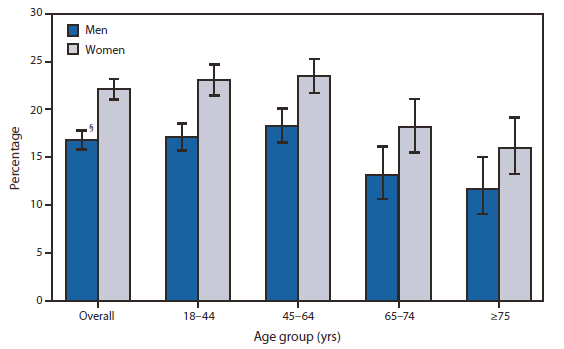Persons using assistive technology might not be able to fully access information in this file. For assistance, please send e-mail to: mmwrq@cdc.gov. Type 508 Accommodation and the title of the report in the subject line of e-mail.
QuickStats: Percentage of Adults Aged ≥18 Years Who Often Felt Worried, Nervous, or Anxious,* by Sex and Age Group — National Health Interview Survey, United States, 2010–2011†

* Based on a survey question that asked respondents, "How often do you feel worried, nervous, or anxious? Would you say daily, weekly, monthly, a few times a year, or never?" Persons reporting daily or weekly feelings of worry, nervousness, or anxiety were categorized as often worried, nervous, or anxious. Unknowns were not included in the denominators when calculating percentages.
† Estimates are based on household interviews of a sample of the U.S. civilian, noninstitutionalized population.
§ 95% confidence interval.
During 2010–2011, women (22.1%) were more likely than men (16.8%) to often feel worried, nervous, or anxious. Among men, those aged 45–64 years were about as likely (18.2%) as men aged 18–44 years (17.1%) but more likely than men aged 65–74 years (13.2%) and ≥75 years (11.7%) to often have feelings of worry, nervousness, or anxiety. Women aged 18–44 years were about as likely (23.0%) as women aged 45–64 years (23.5%) but more likely than women aged 65–74 years (18.1%) and women aged ≥75 years (16.0%) to often feel worried, nervous, or anxious.
Source: National Health Interview Survey, 2010 Quality of Life and 2011 Functioning and Disability supplements. Data were colleccted from a subset of the adults randomly selected for the sample adult component of the NHIS questionnaire. Available at http://www.cdc.gov/nchs/nhis.htm.
Reported by: Debra Blackwell, PhD, debra.blackwell@cdc.hhs.gov, 301-458-4103; Tainya C. Clarke MS, MPH.
Alternate Text: The figure above shows the percentage of adults aged ≥18 years who often felt worried, nervous, or anxious, by sex and age group in the United States during 2010-2011, according to the National Health Interview Survey. During 2010-2011, women (22.1%) were more likely than men (16.8%) to often feel worried, nervous, or anxious. Among men, those aged 45-64 years were about as likely (18.2%) as men aged 18-44 years (17.1%), but more likely than men aged 65-74 years (13.2%) and ≥75 years (11.7%) to often have feelings of worry, nervousness, or anxiety. Women aged 18-44 years were about as likely (23.0%) as women aged 45-64 years (23.5%), but more likely than women aged 65-74 years (18.1%) and women aged ≥75 years (16.0%) to often feel worried, nervous, or anxious.
Use of trade names and commercial sources is for identification only and does not imply endorsement by the U.S. Department of
Health and Human Services.
References to non-CDC sites on the Internet are
provided as a service to MMWR readers and do not constitute or imply
endorsement of these organizations or their programs by CDC or the U.S.
Department of Health and Human Services. CDC is not responsible for the content
of pages found at these sites. URL addresses listed in MMWR were current as of
the date of publication.
All MMWR HTML versions of articles are electronic conversions from typeset documents.
This conversion might result in character translation or format errors in the HTML version.
Users are referred to the electronic PDF version (http://www.cdc.gov/mmwr)
and/or the original MMWR paper copy for printable versions of official text, figures, and tables.
An original paper copy of this issue can be obtained from the Superintendent of Documents, U.S.
Government Printing Office (GPO), Washington, DC 20402-9371;
telephone: (202) 512-1800. Contact GPO for current prices.
**Questions or messages regarding errors in formatting should be addressed to
mmwrq@cdc.gov.
 ShareCompartir
ShareCompartir


